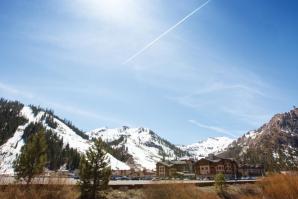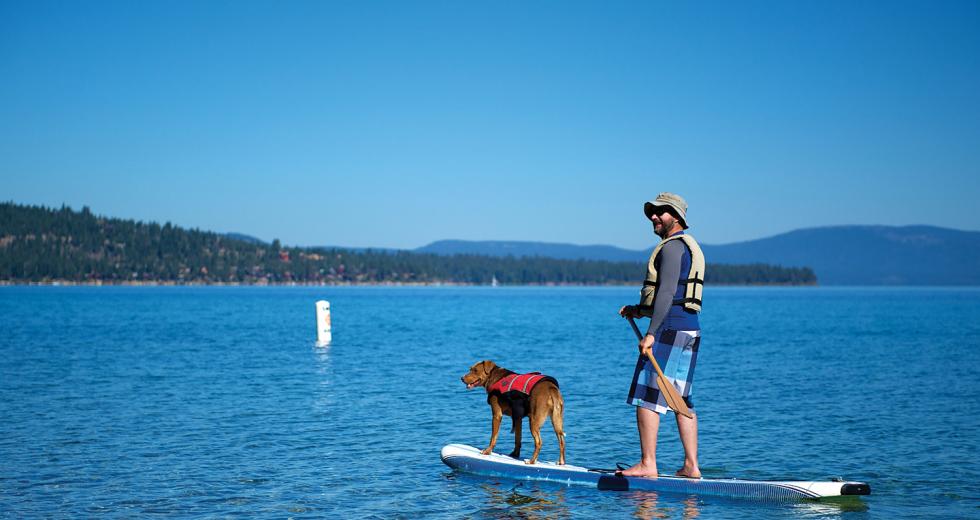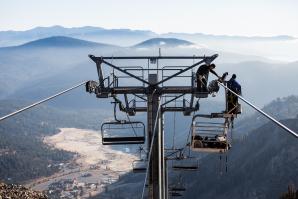With gaming revenue on the decline and environmental sustainability an ongoing concern, the need for a new tourism strategy in Tahoe is two-fold. Enter geotourism.
According to the Tahoe Regional Planning Agency’s 2011 Threshold Evaluation Report, the gaming industry has lost more than 4,000 jobs in the past decade as a result of increased competition. The Nevada Gaming Control board indicates a 24 percent decline in gaming revenue over the same period.
At the same time, the region is still struggling to update its built environment in ways that preserve its natural ecosystem, and according to TRPA, water clarity remains a concern. Since 1997, partners of the Lake Tahoe Environmental Improvement Program have spent more than $1.5 billion to restore the ecosystem.
Geotourism employs a two-pronged attack: Preserve the environment by fostering stewardship through cultural and historical ties, and support the local economy by promoting and encouraging patronage of local businesses. Coined by Jonathan Tourtellot, founding director of the National Geographic Center for Sustainable Destinations and the geotourism editor for National Geographic Traveler, the term encompasses eco-tourism, agri-tourism, volun-tourism and then some. It has support from the Bureau of Indian Affairs, the Bureau of Land Management, the U.S. Fish and Wildlife Service, the National Park Service and the U.S. Forest Service. And the philosophy is gaining serious traction in the Tahoe region.
“It’s not just about the environment,” says Tourtellot. “It certainly includes the environment, but it’s also about history, traditions, culture and the aesthetics of a place.”
Jacquie Chandler, the executive director of Sustainable Tahoe, was appointed a geotourism liason by the National Geographic Center for Sustainable Destinations in 2007. She and John Hara, Sustainable Tahoe’s founder and board chair, are currently gearing up for the fourth annual Tahoe Expo, a two-day geotourism demonstration (Aug. 30-31) that spans 150 miles and features 25 “geotracks” — events and excursions that showcase all the region has to offer. The expo is made possible by the collaboration of 60-plus NGOs, agencies and businesses, and geotracks range from biologist-led kayaking trips to bike rides and fly fishing excursions.
“The expo is more than an event,” Chandler says. “It’s an economic demonstration for long-term prosperity and water clarity. We need to make visitors part of the solution. Instead of one big footprint, we have many tiny footprints spread out over hundreds of miles. It’s a tourism model that can happen everyday.”
The Sierra Business Council picked up the geotourism model back in 2009 when it partnered with the Sierra Nevada Conservancy and National Geographic to launch the Sierra Nevada Geotourism Project. The project’s website, sierranevadageotourism.org, includes a comprehensive, interactive map that highlights everything from community festivals to local B&Bs.
“Every destination on the web map includes an effort to have as little an impact on local environment as possible or promotes maintaining and restoring the environment,” says Brittany Todd, communications specialist for the SBC. “Our focus is on sustaining that unique character of place — environmentally, historically and culturally.”
To help grow the movement, the Tahoe Chamber, in cooperation with the Lake Tahoe Visitors Authority, uses grant money from El Dorado County to shoot videos showcasing local activities, events and businesses that reflect geotourism ideals. The videos are then uploaded to YouTube and the LTVA-run tahoesouth.com.
Tahoe does have a story, and there’s a lot to discover besides ski resorts. Perhaps Tahoe can lead the way back to destination distinctiveness. My hope is that on my next visit, I will be pleasantly surprised.
Jonathan Tourtellot, geotourism editor, National Geographic Traveler
While the site still highlights big-name entertainment events that have little to do with the region’s authentic character, the site’s blog features content written by Tahoe residents lauding assets like hiking trails and local festivals. There’s also the upcoming Sample the Sierra event featuring the local flavor of El Dorado County — essentially El Dorado County’s farm-to-fork festival. According to Tahoe Chamber President Betty Gorman, it’s about more than tourism. The event connects members of the local business community so that local shops and restaurants are featuring locally made products. She says the idea came to her while she was perusing goodies in a local tasting room.
“I was looking at jams and jellies, and they were all from Maine,” she says. “I practically dropped a jar on the floor I was so stunned.”
According to the Tourism Industry of America’s 2011 report, “Geotourism: A New Trend in Travel,” more than 55 million travelers — over half of those surveyed — are interested in the kind of travel experience geotourism promotes. These travelers tend to be educated and have higher disposable incomes. Of the most active geotourists, nearly 30 percent are under the age of 35 and about 30 percent live in the Pacific region. The SBC reports that more than 60 percent of users who visit its geotourism website are between the ages of 18 and 34 — a demographic whose disposable income, and hopefully travel spending, is in a position to grow.
And the movement needn’t necessarily exclude Tahoe’s gaming breadwinners, either. In the past year, the Tahoe Fund and the Truckee River Watershed Council have seen roughly 20 businesses join their Green Bucks program. Participating businesses collect $1 per guest via lift ticket sales or hotel room rates (though patrons have the option to opt out) for conservation and education efforts throughout the Lake Tahoe Basin and Truckee River Watershed. Just last month, MontBleau Resort Casino & Spa presented a check for $18,000 raised through the program.
“If you’re in the hospitality and tourism industry in Tahoe, your business is related to the environment,” says Amy Berry, CEO of the Tahoe Fund. “Casinos know that people don’t have to go to state lines if they want to gamble, but they can’t experience a more beautiful environment than if they do it here.”
But, as with any new movement, getting a slew of independent agencies and entities on the same page is about as easy as corralling cats into a bathtub.
“Right now, everyone is making an effort, but it’s so uncoordinated that the message gets lost,” Berry says. “There’s not a lack of information. There is almost too much information.”
Those trumpeting geotourism are not simply tasked with getting the message out to travelers. They also have to first get a hold of what exactly it means in a particular region, then educate local businesses and other organizations on that meaning and how to get involved.
The Lake Tahoe Outreach Committee, of which the Tahoe Fund is a member, is working to streamline Tahoe’s geotourism strategy. In September it met with 60 stakeholders for a 3-hour workshop to fine tune the region’s branding and will hopefully launch a media campaign in the fall of 2015.
According to Tourtellot, based on his 2007 visit, he would have given Tahoe “reasonably good marks for environment and rather poor marks for culture. The fascinating history of the place is not well-presented, and the Washoe’s story is virtually absent.”
The Washoe are the native people of the Great Basin that have occupied the region for thousands of years. While their culture is largely absent in Tahoe, Sustainable Tahoe is hoping to change that. The Washoe Cultural Resources Advisory Council has allied itself with Sustainable Tahoe and will be participating in this year’s Tahoe Expo by hosting a traditional LukaLeLup, or gathering ceremony, during the two-day event.
“The reason we support what Jacquie (Chandler) is doing is because it is sustainable,” says Darrel Cruz, the advisory council’s director and a member of the Washoe tribe. “Those values she is trying to get across to people, those are our values: Protect and preserve the land for people, animals and wildlife.”
The LukaLeLup will include Washoe storytelling, language education and other traditional practices like archery and basket-weaving demonstrations.
“Tahoe itself is more or less the center of the universe for the Washoe people,” Cruz says. “If there is going to be a story told about the Washoe, it’s better that we tell it in our own words, so that it’s done in a manner that’s consistent with our own values and beliefs.”
According to Chandler, this type of authentic connection to a destination’s history creates a strong sense of place that fosters the stewardship so important to making geotourism a successful model. It’s also what many of the geotourism efforts in the Tahoe region lack. According to the TIA study, the majority of travelers (68 percent) choose destinations based on word of mouth. If Tahoe is to succeed, it will need to give visitors a story to tell.
“Tahoe does have a story, and there’s a lot to discover besides ski resorts,” Tourtellot says. “Perhaps Tahoe can lead the way back to destination distinctiveness. My hope is that on my next visit, I will be pleasantly surprised.”
Can profit and preservation find common ground? Let us know what you think in the comments.
Recommended For You

Survey Says
Squaw Valley has enough water to move forward with village expansion
Squaw Valley Real Estate and KSL Capital Partners, the company that owns Squaw Valley Ski Resort, have received the critical report needed to move forward with a planned expansion of the resort’s village.

World Travel
Can Sacramento cash in on an influx of Chinese tourism dollars?
Two hundred million Chinese tourists will pack their bags and depart their homeland in 2020, bound for destinations across the globe. It’s not a mass exodus; they’re not fleeing their government. They’re tourists, and, according to CNN, they might be the greatest phenomenon to hit the global travel industry since the invention of commercial flight.

#YOLO
The 7 best bike rides in Yolo County
Lovely scenery along gently rolling foothills has always made Yolo County an ideal place for cyclists, but who knew everyone took it so seriously?





Comments
Wonderful work, by wonderful people.
The presentation of information by 'Sustainable Tahoe' regarding the Washoe people is completely misleading. We are not HOLDING a traditional ceremony at Lake Tahoe. The group leading the 'Tahoe Expo' DECIDED to refer to the activities provided by the Washoe as 'Lakalelup' based on the use of the term for a local 'pow wow' which in itself is not a Washoe ceremony (Lakalelup has been misprinted in the article and by 'Sustainable Tahoe' as LukaLeLup on multiple occasions). Lakalelup does not even translate to ceremony it is a reference to a gathering. I understand the article is meant as publicity for the event, but to print anything that has to do with the Washoe Tribe based on what you were told by 3rd party is a complete misappropriation of information and shows the lack of respect and empathy for Native American/Indigenous people. The lack of 'culture' referred to regarding the absence of Washoe presence at Lake Tahoe is a direct result of the large tourist presence. Why don't you guys ask 'Sustainable Tahoe' about some of their previous 'activities' they have done regarding Washoe culture? 'Sustainable Tahoe' doesn't care about Washoe Culture and Ideology, they like most continue to believe we are a thing of the past and only want to use us when it will help them. Rarely are we as Washoe people invited to the table to speak and as you can see, when we are involved, we are not understood.
Hi Herman, Allison Joy here, the writer of the piece. We appreciate your feedback and perspective. I would like to point out that at no point in the article did Sustainable Tahoe provide information regarding the Washoe. All of the information about the Washoe Tribe came from Washoe Tribal Council Member and director of the Washoe Cultural Resources Advisory Council Darrel Cruz.
Nobody can know everything, and mistakes happen - that's life. We try to do our best and engage the communities that we care about. It seems trivial argue spelling, when the objective is to enhance the natural vitality of Lake Tahoe in all aspects from the environment to the cultural roots. To be fair, since the Feds banned fires on Lake Tahoe, there never could be a traditional gathering.
Thank you Allison Joy for this wonderful piece of journalism about a very important issue that effects us all. Organizations like Sustainable Tahoe, Nat Geo and SBC are at the forefront of necessary beneficial change and the time has come in history that such change MUST come about or the human species is going to push the planet over the point of no recovery.
It is incredible difficult to be the first of a public campaign such as this, because as you push up against the comfortable status quo, you become the ones taking the hardest hits from all sides and treading ground that no one else has passed over to provide you directions. The path is bound to be fraught with land mines.
I do commend the hard working and dedicated people of these forward acting organization ~ and especially Sustainable Tahoe because I know that this is an all volunteer group working on a shoestring budget (more like a hope and a prayer). They are truly in it for right reasons, which is to serve the greatest good for all people and to restore humanity's sacred relationship with our Water.
I have some personal involvement with Sustainable Tahoe and I know that they are receiving guidance DIRECTLY from members of the Washoe Cultural Resources Advisory Council (not 3rd party as Herman suggests). The design and naming of the Tahoe Expo Laka'lelup at Sand Harbor on Aug 30 completely originated from the Advisory Council themselves and not from Sustainable Tahoe. Everything that is put out publicly in relation to the Washoe involvement must be approved by the Advisory Council. I believe the misspelled name Lukalelup came from a Washoe produced calendar provide to the personnel of Sustainable Tahoe by the Washoe Cultural Resources Advisory Council (the month of November). Herman does seem to be jumping to conclusions and does not have all the facts ... it is a simple misunderstanding, yet it is an important one to correct because it is simply wrong information.
That being said, I really appreciate hearing Herman's perspective in response to this article ... his is a very vital voice and we would do well to him listen deeply. Respectful to comment by 'Visitor', there is so much more painful and tragic history to be read between the lines of what Herman is speaking about, that his perspective can not be trivialized as only an argument about spelling.
His culture and language are on the brink of being lost to the world, and this directly related to the actions of the European invasion that has occurred over the last 250 years. I truly honor him for being so committed and passionate about his people as to fight for what he believes is true. Thank you Herman for standing up for the future of the Wašiw. Thank you for speaking in your language and teaching it to the world. It is so important.
The dominant European culture IS largely ignorant about our own brutal takeover this continent because accepted history is always written by the victor. The degree at which the original people of this land have been subject to genocide and continue to be marginalized today can not be understated. The Wašiw and the other tribes of the Sierra receive the brunt of the destruction from the Europeans because of the greed for the gold and silver found in the ground of their incredibly beautiful lands. Additionally, they were the last of indigenous tribes in the lower 48 states to be hit by the flood of cultural change, which occurred so quickly and so ruthlessly that their people suffered tragically. They have survived however, and incredibly, they are still here to tell their stories ... if we chose to listen.
(Herman, please correct me if I am wrong on anything I am about to say) To put this into some context ... on this very page of this online magazine, there are two ads for Squaw Valley. We think nothing of this name, yet, few 'anglos' know that the term 'squaw' is very derogatory to indigenous women, being akin to 'whore' or more accurately 'sex slave', because the indigenous women used as 'squaws' by the early immigrants to this continent rarely received payment from the relationships. How would you feel if you had to read this about the women of your culture every day.
The name was coined by the same men that wiped out nearly all of the northern band of the Wašiw. What does this say about the European mindset? Do those of us of European descent have any idea of the generational anguish that the living reality of this western holocaust has caused ... I don't think so. Yet, we must all move forward in the best way we know how regardless of our histories. Staying closed off and bitter does not serve the future.
The remarkable valley that bares this rude, insulting name was a thriving summer home to the Wel Mel Ti, the northern band of the Wašiw. I grew up in that valley and lived there for most of my life ~ only two generations away from a time when it was filled with a vital indigenous community. I could feel their presence, yet I would always wonder how the original people live in this place, what they called the valley, why they had been erased from that place and where they had gone.
I, for one, is someone who is ready to learn and to listen. I am thrilled for the opportunity to attend the Laka'lelup. This is such an wonderful opportunity for education and sharing and healing ... it is my sincere hope that the people of the Wašiw will give the world a chance to see them for the remarkable people that they are and to hear there voices. Thank you all for what you are doing to make the world a much better place for our children and grandchildren!
Hello ~
Is approval of comment posts required before publication?
Because I tried to post a comment twice last night and still do not see it appearing in the list of comments.
Many thanks.
Hi Elizabeth - Yes, as Of now comments go through an approval process, mostly because we only just launched our site about a week ago and want to make sure all spam filters and such are working accordingly. I had thought I approved your original comment early this morning, but I was mistaken. My apologies - typically the turn-around time is much shorter.
If you have further feedback regarding the site, don't hesitate to let us know by posting a comment here: http://www.comstocksmag.com/co...
Or by submitting a contact form here: http://www.comstocksmag.com/co...